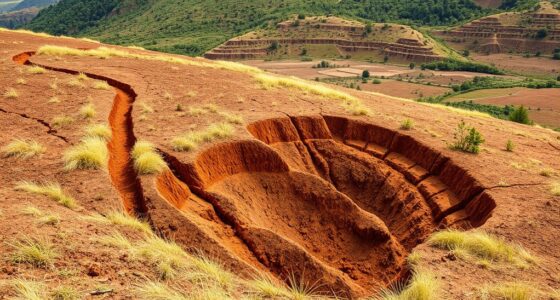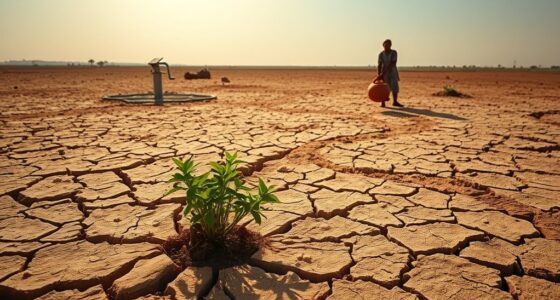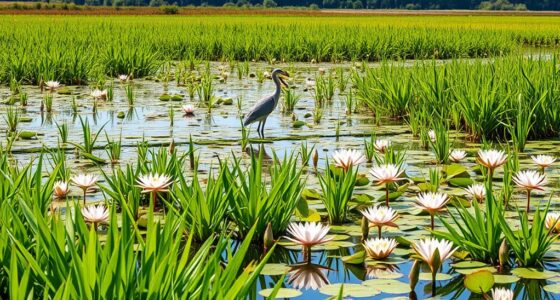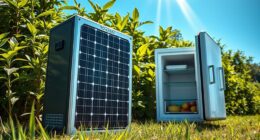Microplastics contaminate water and soil through the breakdown of larger plastics, synthetic textiles, and industrial processes. You can find these tiny particles from discarded waste, washing clothes, and everyday products, which persist due to their resistance to natural degradation. They can accumulate over time, harming wildlife and entering the food chain, including humans. If you want to understand how these plastics impact the environment and what can be done, there’s much more to explore.
Key Takeaways
- Microplastics originate from plastic debris breakdown, synthetic fiber shedding, and industrial processes, contaminating water and soil.
- They enter ecosystems through fragmentation, water transport, and synthetic fiber release during laundering.
- Microplastics are resistant to microbial degradation, leading to long-term environmental persistence.
- They accumulate in organisms, bioaccumulate up the food chain, and pose risks to health and ecosystems.
- Mitigation includes biodegradable plastics, improved waste management, reducing plastic use, and ongoing research into degradation methods.

Microplastics have become a pervasive contaminant in our environment, infiltrating both water sources and soil. These tiny plastic particles originate from a variety of microplastic sources, including the breakdown of larger plastic debris, synthetic textiles, personal care products, and industrial processes. Understanding where microplastics come from is vital because it helps us identify key points where intervention can reduce their presence. For instance, when plastic waste like bottles, bags, or fishing gear degrades over time, it fragments into smaller pieces—microplastics—that are easily transported through water and soil. Similarly, synthetic fibers shed from clothing during washing can enter waterways, adding to the microplastic burden. These sources continuously replenish the microplastic pool in the environment, making it a persistent problem that’s difficult to eliminate.
Once microplastics enter the environment, their persistence is partly due to the slow or limited biodegradation processes. Unlike organic materials, plastics are resistant to microbial breakdown because their chemical structure is designed to be durable. Microbial communities do interact with plastics, but the biodegradation processes occur very gradually, often taking decades or longer. During this slow process, some microbes can form biofilms on plastic surfaces, breaking down certain components, but complete mineralization remains rare. This sluggish degradation means microplastics accumulate over time, contaminating water bodies and soil ecosystems. Their chemical stability allows them to persist, acting as carriers for toxic substances and pollutants, which further complicates environmental impacts. You’ll find that the biodegradation processes are hindered by environmental factors such as temperature, oxygen availability, and the presence of other contaminants, all influencing how quickly—or slowly—microplastics break down. Furthermore, research into biodegradation processes is ongoing to develop biological solutions that could potentially accelerate plastic breakdown.
Because of these sources and the difficulty in biodegrading plastics, microplastics tend to persist in the environment, posing long-term risks to ecosystems and human health. The tiny particles can be ingested by marine and terrestrial organisms, entering the food chain and accumulating in higher organisms, including humans. You can see that addressing microplastic pollution requires a dual focus: reducing microplastic sources and enhancing our understanding of biodegradation processes. Efforts to develop biodegradable plastics or improve waste management practices can help curb the flow of new microplastics into the environment. Meanwhile, ongoing research into biodegradation processes aims to find biological solutions to speed up plastic breakdown. Meanwhile, awareness of microplastic sources emphasizes the importance of reducing plastic use, recycling properly, and supporting policies that limit single-use plastics. Tackling this issue demands a holistic approach that tackles both the sources and the slow natural processes that keep microplastics lingering in our water and soil.
Frequently Asked Questions
How Long Do Microplastics Remain in the Environment?
Microplastics can stay in the environment for decades or even centuries, depending on the degradation timeline. You should know that their environmental persistence means they resist breaking down easily, so they remain in ecosystems much longer than organic materials. Factors like sunlight, temperature, and physical wear influence how quickly microplastics degrade, but overall, they tend to persist for a very long time, posing ongoing pollution challenges.
Can Microplastics Enter the Human Food Chain?
Yes, microplastics can enter your food chain through microplastics ingestion, especially via seafood, drinking water, and even crops grown in contaminated soil. When you consume these, microplastics bioaccumulate in your body, potentially causing health issues over time. This process shows how microplastics move from the environment into your daily diet, making it essential to reduce plastic waste and limit exposure to protect your health.
What Are the Most Common Sources of Microplastics?
Imagine a river of discarded plastic waste flowing through your world; that’s where most microplastics come from. You’ll find synthetic fibers shedding from your clothes, breaking down into tiny particles. Plastic waste from packaging, bottles, and fishing gear also contributes notably. These sources constantly release microplastics into water and soil, silently weaving their way into ecosystems—and eventually, into your daily life.
How Do Microplastics Affect Aquatic and Soil Organisms?
You might not realize it, but microplastics can harm aquatic and soil organisms by causing bioaccumulation impacts that build up in their bodies over time. These tiny particles can also lead to reproductive toxicity, reducing their ability to reproduce successfully. As a result, ecosystems suffer because affected organisms struggle to survive and maintain healthy populations, disrupting biodiversity and ecological balance.
Are There Effective Methods to Remove Microplastics From Water and Soil?
You can combat microplastics with clever cleanup methods. Filtration technologies effectively trap tiny particles, making water safer. Bioremediation strategies use natural organisms to break down plastics in soil. Combining these approaches, you enhance removal processes, reducing environmental impact. While no method is perfect, ongoing advancements in filtration and bioremediation offer promising solutions, helping you safeguard ecosystems and guarantee cleaner water and soil for future generations.
Conclusion
You now see how microplastics infiltrate water and soil, silently sneaking into ecosystems. If you ignore this issue, it’s like closing your eyes to a fire burning nearby. By staying informed and taking action, you can help turn the tide before it’s too late. Remember, every small step counts in cleaning up our planet’s mess. Together, you and I can help clear the waters and soil, restoring nature’s balance before it’s too late.










